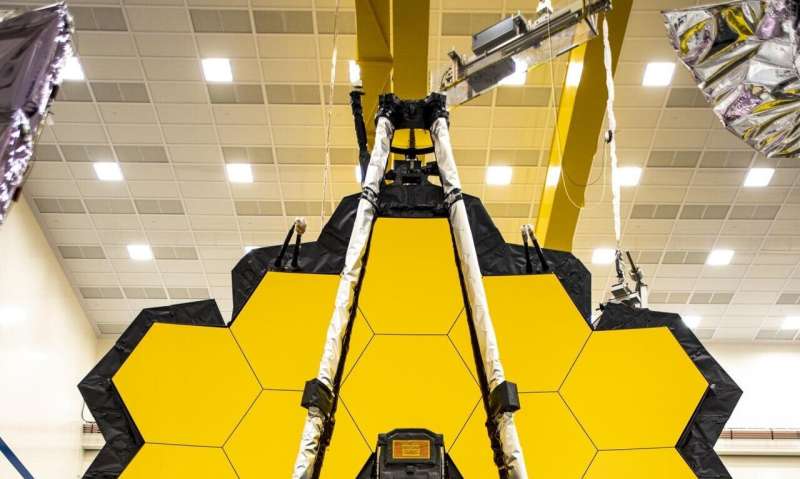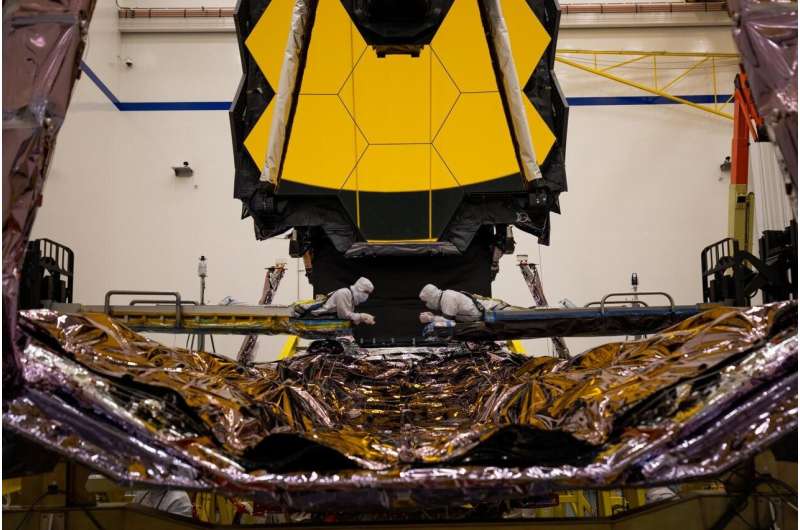Tower extension test a success for NASA's James Webb Space Telescope

To test the James Webb Space Telescope's readiness for its journey in space, technicians successfully commanded it to deploy and extend a critical part of the observatory known as the Deployable Tower Assembly.
The primary purpose of the deployable tower is to create a large gap between the upper part of the observatory that houses its iconic gold mirrors and scientific instruments, and the lower section known as the spacecraft bus which holds its comparatively warm electronics and propulsion systems. By creating a space between the two, it allows for Webb's active and passive cooling systems to bring its mirrors and sensors down to staggeringly cold temperatures required to perform optimal science.
Webb was designed to look for faint traces of infrared light, which is essentially heat energy. To detect the extremely faint heat signals of astronomical objects that are incredibly far away, the telescope itself has to be very cold and stable.
During the test, the tower was slowly extended 48 inches (1.2 meters) upward over the course of several hours, in the same maneuver it will perform once in space. Simulating the zero-gravity environment Webb will operate in, engineers employed an innovative series of pulleys, counterbalances and a special crane called a gravity-negation system that perfectly offloaded all of the effects of Earth's gravity on the observatory. Now that Webb is fully assembled, the difficulty of testing and properly simulating a zero-gravity environment has increased significantly.

"The Deployable Tower Assembly worked beautifully during the test," said Alphonso Stewart the Webb deployment systems lead for NASA's Goddard Space Flight Center in Greenbelt, Maryland. "It performed exactly as predicted, and from our expectations from previous tests before the full observatory was assembled. This was the first time that this part of Webb was tested in its flight-like configuration to the highest level of fidelity we possibly could. This test provides the opportunity to assess all interfaces and interactions between the instrument and bus sections of the observatory."
In addition to helping the observatory cool down, the Deployable Tower Assembly is also a big part of how Webb is able to pack into a much smaller size to fit inside an Ariane 5 rocket for launch. Webb is the largest space science observatory ever built, but to fit a telescope that big into a rocket, engineers had to design it to fold down into a much smaller configuration. Webb's Deployable Tower Assembly helps Webb to just barely fit inside a 17.8-foot (5.4-meter) payload fairing. Once in space, the tower will extend to give the rest of Webb's deployable parts, such as the sunshield and mirrors, the necessary amount of room needed to unpack and unfold into a fully functional infrared space observatory.
"We need to know that Webb will work the way we expect it to before we send it to space," said Stewart. "This is why we test, and when we do, we test as flight-like as possible. The way we send the commands to the spacecraft, the sequence, the individual sitting at the console, the communication that we use. We replicate all of these things to see if we are missing something, to see if there is something that needs to be changed, and to make sure that all of our planning to date has been correct."
Following augmented personal safety procedures due to COVID-19, the James Webb Space Telescope's Northrop Grumman team in California continued integration and testing work with significantly reduced on-site personnel and shifts. The NASA/Northrop Grumman team recently resumed near-full operations. NASA is evaluating potential impacts on the March 2021 launch date, and will continually assess the schedule and adjust decisions as the situation unfolds.
Provided by NASA's Goddard Space Flight Center




















